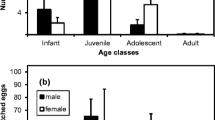Abstract
I investigated the effect of the density of louse eggs (Pedicinus obtusus andP. eurygaster) on grooming site preferences in Japanese macaques (Macaca fuscata). Louse eggs were more often found on the outer side of the body (upper back, lower back, outer arms, and outer legs) than on the inner side of the body (chest, belly, inner arms, and inner legs). Japanese macaques were more likely to be groomed on the outer side than the inner side of the body by allogrooming and autogrooming. Such grooming site preferences correlated with the distribution of louse eggs but not with the areas of body parts. Thus, the ecology of lice might affect grooming behavior of Japanese macaques. Five hundred and fifty louse eggs were estimated to parasitize an adult female Japanese macaque. Considering the intrinsic rate of natural increase of lice, monkeys need to be groomed almost every day. This suggests that Japanese macaques need grooming partners and form social bonds with others for everyday grooming.
Similar content being viewed by others
References
Barton, R. 1985. Grooming site preferences in primates and their functional implications.Int. J. Primatol., 6: 519–532.
Blanc, G.;Woodward, T. E. 1945. The infection ofPedicinus albidus RUDOW the maggot’s louse on typhus carrying monkeys (Macaca sylvanus).Amer. J. Trop. Med., 25: 33–34.
Boccia, M. L. 1983. A functional analysis of social grooming patterns through direct comparison with self-grooming in rhesus monkeys.Int. J. Primatol., 4: 399–418.
Borries, C. 1992. Grooming site preferences in female langurs (Presbytis entellus).Int. J. Primatol., 13: 19–32.
Evans, F. C.;Smith, F. E. 1952. The intrinsic rate of natural increase for the human louse,Pediculus humanus L.Amer. Naturalist, 86: 299–310.
Ewing, H. E. 1935. Sham louse-picking, or grooming, among monkeys.J. Mammal., 16: 303–306.
Furuya, Y. 1957. Grooming behavior in the wild Japanese monkeys.Primates, 1: 47–68. (in Japanese)
Hutchins, M.;Barash, D. P. 1976. Grooming in primates: implications for its utilitarian function.Primates, 17: 145–150.
Kettle, D. S. 1990.Medical and Veterinary Entomology. C · A · B International, Oxon, UK.
Kitaoka, S. 1961. Physiological and ecological studies on some ticks: VII. Parthenogenetic and bisexual races ofHaemaphysalis bispinosa in Japan and experimental crossing between them.Natl. Inst. Anim. Hlth. Quart., 1: 142–149.
McKenna, J. J. 1978. Biosocial functions of grooming behavior among the common Indian langur monkey (Presbytis entellus).Amer. J. Phys. Anthropol., 48: 503–510.
Nakayama, T.;Hori, T.;Nagasaka, T.;Tokura, H.;Tadaki, E. 1971. Thermal and metabolic responses in the Japanese monkey at temperatures of 5 – 38°C.J. Appl. Physiol., 31: 332–337.
Reichard, U.;Sommer, V. 1994. Grooming site preferences in wild white-handed gibbons (Hylobates lar).Primates, 35: 369–374.
Sánchez-Villagra, M. R.;Pope, T. R.;Salas, V. 1998. Relation of intergroup variation in allogrooming to group social structure and ectoparasite loads in red howlers (Alouatta seniculus).Int. J. Primatol., 19: 473–491.
Saunders, C. D.;Hausfater, G. 1988. The functional significance of baboon grooming behavior.Ann. N. Y. Acad. Sci., 525: 430–432.
Tanaka, I.;Takefushi, H. 1993. Elimination of external parasites (lice) is the primary function of grooming in free-ranging Japanese macaques.Anthropol. Sci., 101: 187–193.
T-W-Fiennes, R. N. 1972. Ectoparasites and vectors. In:Pathology of Simian Primates, Part II,T-W-Fiennes, R. N. (ed.), Basel, New York, pp. 158–176.
Zinsser, H. 1934.Rats, Lice and History. The Atlantic Monthly Press, New York.
Author information
Authors and Affiliations
About this article
Cite this article
Zamma, K. Grooming site preferences determined by lice infection among Japanese macaques in Arashiyama. Primates 43, 41–49 (2002). https://doi.org/10.1007/BF02629575
Received:
Accepted:
Issue Date:
DOI: https://doi.org/10.1007/BF02629575




